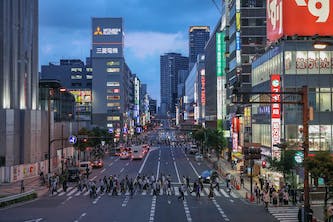It’s really important to make cars safer for people who walk, ride bikes, or use scooters. Jessica Hart, who is part of a group called DC Families for Safe Streets, thinks we need to have better streets, more careful drivers, and safer cars. She says that when people buy cars, they usually think about the price and how safe it is for the people inside, but they don’t always think about the safety of people outside the car.
New technology is helping to make things safer for people who walk. Cars are being made with things like airbags for pedestrians, bonnets that pop up, and systems that automatically brake if they sense a person in front of the car. But these features can be expensive, so car companies are trying to make them more affordable.
One big challenge is figuring out how to make cars safer for people who walk or ride bikes. Some car parts, like the pillars around the windshield, can be really dangerous for them. Volvo has come up with airbags for pedestrians and bonnets that pop up to help with this, but not all car companies are using these ideas yet.
It’s not just about having things in the car that help after an accident. There are also systems that can help prevent accidents from happening in the first place. These systems are getting better at using sensors to detect not only people walking, but also people on bikes. The speed and size of a car also make a big difference in how bad an accident can be, especially bigger cars like SUVs.
The rules and tests for how safe cars are for people who walk are getting better. For example, a group in Europe called Euro NCAP now looks at how safe cars are for people getting out of them, and in the US, the National Highway Traffic Safety Administration is thinking about making rules for how safe cars need to be for people who walk. The goal is to stop really bad accidents and make cars safer for everyone.
Original news source: How to make cars less dangerous for pedestrians (BBC)
Listen
Slow
Normal
Fast
Group or Classroom Activities
Warm-up Activities:
– Opinion Poll
Instructions: Prepare a list of statements related to car safety features mentioned in the article (e.g., “Pedestrian airbags should be mandatory in all new cars”). Have students move to different areas of the room based on their level of agreement (strongly agree, agree, neutral, disagree, strongly disagree). Afterward, facilitate a discussion where students must explain their positions.
– News Reporter Role-play
Instructions: Divide the class into pairs. One student is a news reporter, the other is an expert on car safety technologies. The news reporter conducts an interview with the ‘expert’ based on information from the article. Encourage the use of specific vocabulary and details from the text.
– Vocabulary Pictionary
Instructions: Write down key terms from the article (e.g., “bonnet,” “sensor,” “pedestrian,” “airbags,” “SUV”). Students take turns drawing the terms on the board without speaking or writing words, while the rest of the class guesses the vocabulary.
– Think-Pair-Share
Instructions: Pose a question related to the article, such as “How can technology further improve safety for pedestrians?” Students first think individually, then pair up to discuss their ideas, and finally, share their thoughts with the class, encouraging them to use new vocabulary and structures they’ve learned.
– Future Predictions
Instructions: Ask students to write down their predictions about the future of car safety, using information from the article as a starting point. They might consider technological advancements, changes in regulations, or societal shifts. After writing, they share their predictions with a partner or the class and discuss the likelihood and potential impact of these predictions.
Comprehension Questions:
1. What does Jessica Hart believe needs improvement to enhance safety for pedestrians and cyclists?
2. What kind of new technologies are being developed to protect people outside the car?
3. Why might it be difficult for everyone to have access to cars with pedestrian safety features?
4. What specific car parts are mentioned as being particularly hazardous to pedestrians and cyclists?
5. What solutions has Volvo introduced to address the dangers posed by certain car parts?
6. Besides protective features, what other systems are being improved to prevent accidents from occurring?
7. How do the size and speed of a car affect the severity of an accident?
8. What are Euro NCAP and the National Highway Traffic Safety Administration doing to improve pedestrian safety in relation to cars?
Go to answers ⇩
Listen and Fill in the Gaps:
It’s really important to make cars safer for people who walk, ride bikes, or use scooters. (1)______ Hart, who is part of a group called DC Families for Safe Streets, (2)______ we need to have better streets, more careful drivers, and safer cars. She says that when people buy cars, they usually (3)______ about the price and how safe it is for the people inside, but they don’t always think about the (4)______ of people outside the car.
New technology is helping to make things safer for (5)______ who walk. Cars are being made with things like airbags for pedestrians, bonnets that pop up, and systems that automatically (6)______ if they sense a person in front of the car. But these features can be expensive, so car companies are trying to make them more affordable.
One big challenge is figuring out how to make cars safer for people who walk or ride bikes. Some car (7)______, like the pillars around the windshield, can be really (8)______ for them. Volvo has come up with (9)______ for pedestrians and (10)______ that pop up to help with this, but not all car companies are using these ideas yet.
It’s not just about (11)______ things in the car that help after an accident. There are also systems that can help prevent accidents from happening in the first place. These systems are getting better at using (12)______ to detect not only people walking, but also people on bikes. The speed and size of a car also make a big difference in how bad an accident can be, especially bigger cars like SUVs.
The (13)______ and tests for how safe cars are for people who walk are getting (14)______. For example, a group in (15)______ called Euro NCAP now looks at how safe cars are for people getting out of them, and in the US, the National Highway (16)______ Safety Administration is thinking about making rules for how safe cars need to be for people who walk. The goal is to stop really bad accidents and make cars safer for everyone.
Go to answers ⇩
Discussion Questions:
Students can ask a partner these questions, or discuss them as a group.
1. What is one thing you think car companies should do to make cars safer for people outside of the vehicle?
2. How would you feel if your city made it a law for all cars to have pedestrian safety features?
3. Do you like the idea of having airbags on the outside of cars for pedestrians? Why or why not?
4. Do you think the price of a car should increase if it means the car is safer for everyone? Why?
5. Have you or someone you know ever been in a situation where pedestrian safety features could have helped? What happened?
6. What is your opinion on bigger cars like SUVs? Do you think they should have stricter safety requirements?
7. How would you feel if you found out the car you’re riding in doesn’t have good safety features for pedestrians?
8. Do you think your government is doing enough to make sure cars are safe for people who walk or ride bikes?
9. What is more important to you when buying a car: how it looks, how much it costs, or how safe it is for everyone?
10. How do you think we can encourage more people to care about the safety of pedestrians, not just the people in the car?
11. Have you ever seen a car with pedestrian safety features like automatic braking? What did you think about it?
12. Do you think driving tests should include how to use and understand pedestrian safety technologies?
13. What is one way you think we can make streets safer for people who aren’t in cars?
14. How would you feel if your favorite car brand didn’t offer any pedestrian safety features?
15. Do you think bikes and scooters should also have some kind of safety features to protect pedestrians? What kind?
Individual Activities
Vocabulary Meanings:
Match each word to its meaning.
Words:
1. safer
2. pedestrians
3. bonnets
4. sensors
5. accidents
6. SUVs
7. Euro NCAP
8. Administration
Meanings:
(a) People who are walking on the street
(b) A group that makes and enforces rules
(c) Making sure something is less likely to cause harm
(d) Devices that can detect movement or activity
(e) An organization in Europe that tests car safety
(f) Large, spacious cars often used for off-road driving
(g) The part of the car that covers the engine
(h) Unplanned events that can cause harm or damage
Go to answers ⇩
Multiple Choice Questions:
1. What is one thing Jessica Hart thinks we need to have for safer streets?
(a) More traffic lights
(b) Faster cars
(c) Louder horns
(d) Better streets
2. What is one new technology that is helping to make cars safer for people who walk?
(a) Bigger windows
(b) Airbags for pedestrians
(c) Louder engines
(d) Brighter headlights
3. What is one challenge in making cars safer for people who walk or ride bikes?
(a) The color of the cars
(b) Car parts that can be dangerous
(c) The type of tires
(d) The number of cup holders
4. What is one system that can help prevent accidents from happening in the first place?
(a) Systems for playing music
(b) Systems for heating the seats
(c) Systems using sensors to detect people walking or on bikes
(d) Systems for changing the radio station
5. What group in Europe looks at how safe cars are for people getting out of them?
(a) Euro NCAP
(b) Euro FIFA
(c) Euro NBA
(d) Euro NFL
6. What group in the US is thinking about making rules for how safe cars need to be for people who walk?
(a) National Basketball Association
(b) National Football League
(c) National Highway Traffic Safety Administration
(d) National Hockey League
7. What is one goal of making cars safer for people who walk?
(a) To stop really bad accidents
(b) To make cars faster
(c) To make cars more expensive
(d) To make cars bigger
8. What is one feature that cars are being made with to help make things safer for people who walk?
(a) Bigger exhaust pipes
(b) Louder horns
(c) Brighter headlights
(d) Bonnets that pop up
Go to answers ⇩
True or False Questions:
1. Some car parts, like the pillars around the windshield, are harmless for pedestrians and cyclists, but Volvo has not come up with solutions like pedestrian airbags and pop-up bonnets.
2. The ultimate goal is not to reduce the number of severe accidents and make cars safer for everyone on the road.
3. Organizations like Euro NCAP and the National Highway Traffic Safety Administration are not working on making rules and tests to ensure cars are safer for pedestrians and cyclists.
4. There are no systems in cars that can help prevent accidents from happening, by using sensors to detect people walking or biking.
5. Car companies are working on making these safety features more affordable for consumers.
6. The size and speed of a car can greatly affect the severity of an accident, especially with larger vehicles like SUVs.
7. Jessica Hart is part of a group called DC Families for Safe Streets and believes that cars need to be made safer for pedestrians, cyclists, and scooter users.
8. New technology in cars, such as airbags for pedestrians and automatic braking systems, is helping to improve safety for people who walk.
Go to answers ⇩
Write a Summary:
Write a summary of this news article in two sentences.
Check your writing now with the best free AI for English writing!
Writing Questions:
Answer the following questions. Write as much as you can for each answer.
Check your answers with our free English writing assistant!
1. According to Jessica Hart, what three things need improvement to enhance safety for pedestrians and cyclists?
2. What are some of the new technologies being developed to protect people outside of the car?
3. Why might some car companies be hesitant to implement features like pedestrian airbags and pop-up bonnets?
4. How do the size and speed of a vehicle impact the severity of an accident involving a pedestrian or cyclist?
5. What steps are European and American organizations taking to improve vehicle safety for pedestrians?
Answers
Comprehension Question Answers:
1. What does Jessica Hart believe needs improvement to enhance safety for pedestrians and cyclists?
Jessica Hart thinks we need better streets, more careful drivers, and safer cars, especially considering the safety of people outside the car, not just those inside.
2. What kind of new technologies are being developed to protect people outside the car?
New technologies include pedestrian airbags, bonnets that lift to cushion impacts, and automatic braking systems that activate when a person is detected in front of the car.
3. Why might it be difficult for everyone to have access to cars with pedestrian safety features?
These safety features can be expensive, so car companies need to work on making them more affordable for everyone.
4. What specific car parts are mentioned as being particularly hazardous to pedestrians and cyclists?
The pillars around the windshield are mentioned as being particularly dangerous for pedestrians and cyclists.
5. What solutions has Volvo introduced to address the dangers posed by certain car parts?
Volvo has introduced pedestrian airbags and bonnets that pop up to make the car less dangerous in the event of a collision with a pedestrian.
6. Besides protective features, what other systems are being improved to prevent accidents from occurring?
Systems that use sensors to detect pedestrians and cyclists and help prevent accidents, like advanced driver-assistance systems, are being improved.
7. How do the size and speed of a car affect the severity of an accident?
The bigger and faster a car is, the more severe an accident can be, especially for pedestrians and cyclists who are hit by the car.
8. What are Euro NCAP and the National Highway Traffic Safety Administration doing to improve pedestrian safety in relation to cars?
Euro NCAP is now evaluating how safe cars are for people getting out of them, while the National Highway Traffic Safety Administration is considering new rules for car safety in relation to pedestrians.
Go back to questions ⇧
Listen and Fill in the Gaps Answers:
(1) Jessica
(2) thinks
(3) think
(4) safety
(5) people
(6) brake
(7) parts
(8) dangerous
(9) airbags
(10) bonnets
(11) having
(12) sensors
(13) rules
(14) better
(15) Europe
(16) Traffic
Go back to questions ⇧
Vocabulary Meanings Answers:
1. safer
Answer: (c) Making sure something is less likely to cause harm
2. pedestrians
Answer: (a) People who are walking on the street
3. bonnets
Answer: (g) The part of the car that covers the engine
4. sensors
Answer: (d) Devices that can detect movement or activity
5. accidents
Answer: (h) Unplanned events that can cause harm or damage
6. SUVs
Answer: (f) Large, spacious cars often used for off-road driving
7. Euro NCAP
Answer: (e) An organization in Europe that tests car safety
8. Administration
Answer: (b) A group that makes and enforces rules
Go back to questions ⇧
Multiple Choice Answers:
1. What is one thing Jessica Hart thinks we need to have for safer streets?
Answer: (d) Better streets
2. What is one new technology that is helping to make cars safer for people who walk?
Answer: (b) Airbags for pedestrians
3. What is one challenge in making cars safer for people who walk or ride bikes?
Answer: (b) Car parts that can be dangerous
4. What is one system that can help prevent accidents from happening in the first place?
Answer: (c) Systems using sensors to detect people walking or on bikes
5. What group in Europe looks at how safe cars are for people getting out of them?
Answer: (a) Euro NCAP
6. What group in the US is thinking about making rules for how safe cars need to be for people who walk?
Answer: (c) National Highway Traffic Safety Administration
7. What is one goal of making cars safer for people who walk?
Answer: (a) To stop really bad accidents
8. What is one feature that cars are being made with to help make things safer for people who walk?
Answer: (d) Bonnets that pop up
Go back to questions ⇧
True or False Answers:
1. Some car parts, like the pillars around the windshield, are harmless for pedestrians and cyclists, but Volvo has not come up with solutions like pedestrian airbags and pop-up bonnets. (Answer: False)
2. The ultimate goal is not to reduce the number of severe accidents and make cars safer for everyone on the road. (Answer: False)
3. Organizations like Euro NCAP and the National Highway Traffic Safety Administration are not working on making rules and tests to ensure cars are safer for pedestrians and cyclists. (Answer: False)
4. There are no systems in cars that can help prevent accidents from happening, by using sensors to detect people walking or biking. (Answer: False)
5. Car companies are working on making these safety features more affordable for consumers. (Answer: True)
6. The size and speed of a car can greatly affect the severity of an accident, especially with larger vehicles like SUVs. (Answer: True)
7. Jessica Hart is part of a group called DC Families for Safe Streets and believes that cars need to be made safer for pedestrians, cyclists, and scooter users. (Answer: True)
8. New technology in cars, such as airbags for pedestrians and automatic braking systems, is helping to improve safety for people who walk. (Answer: True)
Go back to questions ⇧













